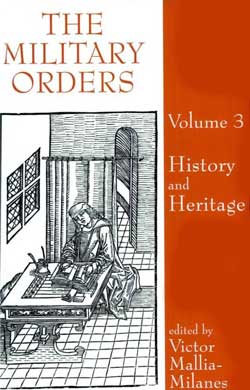
De Re Militari | Book Reviews
Victor Mallia-Milanes (ed.)
The Military Orders, Volume 3: History and Heritage
Ashgate, 2008. 328 pp. €115. ISBN: 978-0-7546-6290-7

The London Quadrennial conferences hosted by the Hospital Order and the London Centre for the Study of the Crusades have already become a modern classic within the historiography of the Military Orders. The present volume is comprised for the most part by the papers read at the third meeting held in September 2000—after an editing and publishing nightmare of eight years. Some of the papers were lost along the way, others were withdrawn and many of them have become outdated. Fortunately the final editor allowed the writers to update their papers before the final publication. Most of the authors took this opportunity, and have updated some of their conclusions and their bibliography, but it is clear that something that could have been groundbreaking if published in 2002 is not in the front line in 2008 (the very same year that the fourth conference proceedings from the 2005 meeting also saw the light).
At any rate, the present volume has as general title The Military Orders: History and Heritage. The volume is divided into four sections: historiography, liturgy and fiction, general issues on templars and teutonics knights, and, finally, the Hospital Order. Although most of the papers deal with the role of the Military Orders in Malta, Cyprus and the Latin East, other scenarios are contemplated such as the Baltic, central and eastern Europe and Iberia. In addition, a few papers have something to do with arts as well (8 of 30).
The first section opens with an article by A. Lutrell on Hospitaller historiography. The paper defended by Luis Garcia Guijarro offers a suggestive and provocative view of the Spanish historiography on the Crusades and the Military Orders. Luis Garcia is right in several points, but perhaps the way he expounds them is not very polite and it will surely not receive a great deal of sympathy among Spanish academics. In the same line, Maria Starnawska offers a general but clear survey of the unknown Polish historiography on the Military Orders.
In the second section, we can find approaches to some aspects of the life of the Hospital Order (heraldry, liturgy, funerary rites and stories), while the third section is a kind of melting pot of different issues related to the history of the templar and teutonic order.
Perhaps we could point out the articles by P. Crawford on the University of Paris and the trial of the Templars and Barbara Bombi´s on the origins of the Swordbrothers. We must add a very interesting investigation by Axel Ehler about the use of indulgences by the Teutonic Order. This last paper should be read opposed to Riley Smith´s A Short History of the Crusades on the “perpetual crusade” lead by the deutsche orden. Besides, R. Hiestand’s older thesis claiming that the papacy did not use the military orders (i.e., the Temple and the Hospital) in crusade preaching should be read in a new light thanks to Ehlers data. Sven Ekdahl´s article on the commemorations of the battle of Grunwald follow one of his last lines of research about linking medieval events to present time world.
Finally, the fourth section focuses again on the Hospital Order. And indeed this is the most interesting part for those scholars working on this Order. Within this chapter, we find contributions by very well known scholars in that field such as Carlos Barquero, Helen Nicholson, Theressa Vann, Johannes Mol and Judith Bronstein, among others. Their papers deal with the local, political, artistic, economic, hospitaller and military roles of the Order. In addition, there are two archaeological investigations by Edna Stern and P. Mitchel.
To sum up. This is a must for all those people interested in the Hospital Order. Besides we can find vey informative and suggesting aportations on historiography. But some of the points presented in this volume have already been shown elsewhere due to the delay in its publication. Furthermore one should not miss the considerable contributions on other Military Orders besides the Hospital (18 articles out of 30) and the Temple (6 articles).
